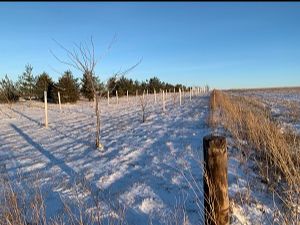Windbreak School Sweeping its Way Across Iowa
Workshop planned for Tama Co to help Iowans protect property from wind

Iowa windbreak. Combining conifers, hardwoods and shrubs in windbreaks provides diverse income options for producers. Photo courtesy Iowa State University Extension and Outreach
Iowa is in desperate need of a windbreak renaissance, according to a forestry specialist with Iowa State University Extension and Outreach.
“Windbreaks and shelterbelts act as critical farm infrastructure – providing energy savings, livestock growth gains, timber and non-timber forest products, wildlife habitat, odor and dust control, aesthetics, and privacy,” according to Billy Beck, who is also an assistant professor at Iowa State. “However, Iowa’s aging windbreaks are simply not functioning as they should be, due to general decline, storm damage, and insect and disease issues.”
Beck will lead multiple upcoming educational sessions intended to help Iowans construct and maintain quality windbreaks, beginning with a Jan. 12 presentation at the Crop Advantage Series in Ankeny. He will give the same presentation Jan. 13 in Cedar Falls and Jan. 20 in Atlantic.
In addition, he will hold an in-depth presentation Feb. 8 in Tama County, where he will present “Windbreak School,” a workshop on establishing, managing and renovating windbreaks.
This free, in-person event will focus on promoting the proper establishment, management and renovation techniques that will ensure successful and effective windbreaks.
Topics will include the science behind windbreaks; site, species and design considerations for multiple objectives; planning and planting; maintenance; on-farm economic value; cost share, technical service advice and more.
Beck said windbreaks provide a simple service, but planning their design and location is key. Windbreaks can take many years to fully establish, and a faulty windbreak can cause unintended consequences.
He recommends that landowners work with the Natural Resources Conservation Service in determining the best windbreak for their property. The soil, location, type and height of the windbreak are all factors, especially with cost share projects.
Other speakers at the Feb. 8 workshop include Ed Zaworski, plant pathologist for the Plant and Insect Diagnostic Clinic at Iowa State; district foresters with the Iowa Department of Natural Resources; NRCS staff; and Cheryl Bruene, of the ISU Extension and Outreach Tama County office.
Pre-registration is requested by Feb. 4. To register, contact the ISU Extension and Outreach Tama County office at 641-484-2703.
If unable to attend in person, watch for the forthcoming CropsTV “Windbreak School” webinar that will be available in late winter on the archived video page.
Check the “Upcoming Forestry Events” page on the Iowa State Extension Forestry website for details on this series, and other extension forestry events.






